Roller coaster
A roller coaster, or rollercoaster, is a type of amusement ride that employs a form of elevated railroad track designed with tight turns, steep slopes, and sometimes inversions.[1] Passengers ride along the track in open cars, and the rides are often found in amusement parks and theme parks around the world.[1] LaMarcus Adna Thompson obtained one of the first known patents for a roller coaster design in 1885, related to the Switchback Railway that opened a year earlier at Coney Island.[2][3] The track in a coaster design does not necessarily have to be a complete circuit, as shuttle roller coasters demonstrate. Most roller coasters have multiple cars in which passengers sit and are restrained.[4] Two or more cars hooked together are called a train. Some roller coasters, notably Wild Mouse roller coasters, run with single cars.
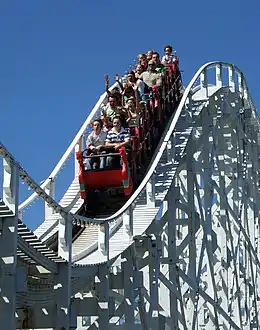
History
The Russian mountain and the Aerial Promenades
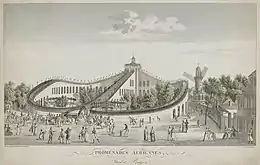
The oldest roller coasters are believed to have originated from the so-called "Russian Mountains", specially constructed hills of ice located in the area that is now Saint Petersburg, Russia.[5] Built in the 17th century, the slides were built to a height of between 21 and 24 m (70 and 80 feet), had a 50-degree drop, and were reinforced by wooden supports. Later, in 1784, Catherine the Great is said to have constructed a sledding hill in the gardens of her palace at Oranienbaum in St. Petersburg.[6]Bennett, David (1998). Roller Coaster: Wooden and Steel Coasters, Twisters and Corkscrews. Edison, New Jersey: Chartwell Books. 9. ISBN 0-7865-0885-X.
The first modern roller coaster, the Promenades Aériennes, opened in Parc Beaujon in Paris on July 8, 1817.[7] It featured wheeled cars securely locked to the track, guide rails to keep them on course, and higher speeds.[8] It spawned half a dozen imitators, but their popularity soon declined.
However, during the Belle Epoque they returned to fashion. In 1887, Spanish entrepreneur Joseph Oller, co-founder of the Moulin Rouge music hall, constructed the Montagnes Russes de Belleville, "Russian Mountains of Belleville" with 656 feet (200 m) of track laid out in a double-eight, later enlarged to four figure-eight-shaped loops.[9]

Scenic railways
In 1827, a mining company in Summit Hill, Pennsylvania constructed the Mauch Chunk Switchback Railway, a downhill gravity railroad used to deliver coal to Mauch Chunk, Pennsylvania – now known as Jim Thorpe.[10] By the 1850s, the "Gravity Road" (as it became known) was selling rides to thrill seekers. Railway companies used similar tracks to provide amusement on days when ridership was low.
Using this idea as a basis, LaMarcus Adna Thompson began work on a gravity Switchback Railway that opened at Coney Island in Brooklyn, New York, in 1884.[11] Passengers climbed to the top of a platform and rode a bench-like car down the 600-foot (183 m) track up to the top of another tower where the vehicle was switched to a return track and the passengers took the return trip.[12] This track design was soon replaced with an oval complete circuit.[8] In 1885, Phillip Hinkle introduced the first full-circuit coaster with a lift hill, the Gravity Pleasure Road, which became the most popular attraction at Coney Island.[8] Not to be outdone, in 1886 Thompson patented his design of roller coaster that included dark tunnels with painted scenery. "Scenic railways" were soon found in amusement parks across the county.[8]
Popularity, decline, and revival
By 1919, the first underfriction roller coaster had been developed by John Miller.[13] Over the next decade, roller coasters spread to amusement parks around the world and began an era in the industry often referred to as the "Golden Age". One of the most well-known from the period is the historical Cyclone that opened at Coney Island in 1927. The onset of the Great Depression in the 1930s, however, significantly impacted the amusement park industry and brought an end to the rapid growth experienced during the Golden Age. This aside, roller coasters were still built with varying success from location to location. In May 1932, the Scene Railway witnessed somewhat of a revival in the UK, including the opening of the roller coaster at Great Yarmouth. Today it is one of only two scenic railways still in operation in the UK.
In 1959, Disneyland introduced a design breakthrough with Matterhorn Bobsleds, the first permanent roller coaster to use a tubular steel track. Designed by Arrow Development, the tubular track was unlike standard rail design on wooden coasters, allowing the track to bend in sharper angles in any direction, leading to the incorporation of loops, corkscrews, and inversion elements into track layouts. A little more than a decade later, the immediate success of The Racer at Kings Island in 1972 sparked a new era of roller coaster enthusiasm, which led to a resurgence across the amusement park industry over the next several decades.
Etymology
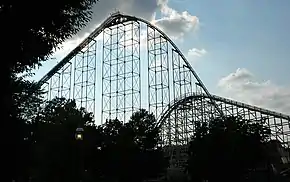
There are several explanations for the name roller coaster. It is said to have originated from an early American design where slides or ramps were fitted with rollers over which a sled would coast.[8] This design was abandoned in favor of fitting the wheels to the sled or other vehicles, but the name endured.
Another explanation is that it originated from a ride located in a roller skating rink in Haverhill, Massachusetts in 1887. A toboggan-like sled was raised to the top of a track which consisted of hundreds of rollers. This Roller Toboggan then took off down gently rolling hills to the floor. The inventors of this ride, Stephen E. Jackman and Byron B. Floyd, claim that they were the first to use the term "roller coaster".[12]
The term jet coaster is used for roller coasters in Japan, where such amusement park rides are very popular.[14]
In many languages, the name refers to "Russian mountains". Contrastingly, in Russian, they are called "American mountains". In the Scandinavian languages, the roller coaster is referred as "mountain-and-valley railway". German knows the word "Achterbahn", stemming from "Figur-8-Bahn", like Dutch "Achtbaan", relating to the form of the number 8 ("acht" in German and also Dutch).
Mechanics
Roller coaster trains are not typically powered. Most are pulled up a lift hill by a chain or cable and released downhill. The potential energy accumulated by the rise in height is transferred to kinetic energy, which is then converted back into potential energy as the train rises up the next hill. Changes in elevation become smaller throughout the track's course, as some mechanical energy is lost to friction and air drag. A properly-designed, outdoor track will result in a train having enough kinetic energy to complete the entire course under a variety of stressful weather conditions.
Not all coasters feature a lift hill, however. A train may also be set into motion by a launch mechanism such as a flywheel, linear induction motor (LIM), linear synchronous motor (LSM), hydraulic launch, or drive tire. Some launched roller coasters are capable of reaching greater speeds using less track when compared to traditional coasters that rely on a conventional lift hill.
A brake run at the end of the circuit is the most common method of stopping a roller coaster train as it returns to the station. One notable exception is a powered roller coaster, which instead of relying on gravity uses one or more motors to propel the trains along the course.
In 2006, NASA announced that it would build a system using principles similar to those of a roller coaster to help astronauts escape the Ares I launch pad in an emergency,[15] although this has since been scrapped along with the rest of the Ares program.
Safety
Safety mechanisms and technology
A variety of safety mechanisms protect riders on roller coasters. One of these is the block system. Most large roller coasters have the ability to run two or more trains at once, and the block system prevents these trains from colliding. In this system, the track is divided into two or more sections known as blocks. Only one train is permitted in each block at any given time. There is a section of track at the end of each block where a train can be stopped if necessary, such as preventing dispatch from the station, stopping a lift, or simply applying brakes. Sensors detect when a train passes so that the system's computer is aware of which blocks are occupied. If a train attempts to enter an occupied block, the stopping mechanisms in all blocks are engaged. Restraints are another critical aspect to roller coaster safety.
Generally speaking, roller coasters usually have two different types: Over-the-shoulder-Restraints and lap bar restraints. With both, Hydraulic and mechanical safety mechanisms are used within the restraints. Mechanical restraints use a system known as a ratchet and pawl. When riding a roller coaster with a ratchet and pawl system, the sound of clicks can be heard when pulling down the restraint.[16] Hydraulic restraints use a piston and cylinder. Unlike mechanical restraints, there is no feeling of physical or sound of clicks from the restraint being locked in place.[17] Most modern day roller coasters have sensors that are used to make sure each restraint is locked. If all the restraints are locked, it will send a signal to the ride computer letting it know that it is clear for dispatch. If all restraints are not locked, the train will not be able to move out of the station until each restraint is locked.[18]
Braking systems such pivoting paws are used on the bottom of the train and on the inclined lift hill. While the cart goes up the lift hill, it is usually pulled by a chain. The pawl moves over bumps that are separated closely apart. In the event that the train ever becomes disconnected from the chain, the anti roll-back system will engage and it will fall back into the nearest downhill stop preventing the train from falling down the lift hill.[19]
Another key to safety is the programmable logic controller (PLC), an essential component of a roller coaster's computer system. Multiple PLCs work together to detect faults associated with operation and automate decisions to engage various elements (e.g. lift, brakes, etc.). Periodic maintenance and visual inspection by ride engineers are also important to verify that structures and materials are within expected wear tolerances and functioning correctly. Effective operating procedures further enhance safety as well.
Roller coaster design & statistics
Roller coaster design is another important aspect that requires a working knowledge of basic physics to enhance ride comfort and avoid harmful strain to the rider. Ride designers must carefully analyze the movement a ride subjects its riders to, ensuring it is within a reasonable tolerance. The human body needs sufficient time to react to sudden changes in force in order to control muscle tension and avoid harmful consequences such as whiplash. Designers typically try to stay in the range of 4–6Gs (40–60 m s−2) as a maximum for positive g-force acceleration, which increases the feeling of weight and pushes riders downward into their seat. For negative g-force, or the feeling of weightlessness, the target is 1.5–2Gs (15–20 m s−2) as a maximum.[ These fall into a range considered safe to a majority of the population. Lateral acceleration is also typically kept under 2Gs using various techniques including the banking of curves.[20]
Wheels are a critical part in rollercoaster design. The purpose of wheels is the keep the train on the track and to prevent it from flying off. A majority of roller coaster wheels are made from polyurethane. There are 3 kinds of roller coaster wheels which include road wheels, side friction wheels, and up-stop wheels. Road wheels ride on top of the track. Side friction wheels ride on the side of the track so that the train can move through turns without flying off the side of the track. Up-stop wheels are the wheels that ride below the track and prevent it from lifting off the track.[21]
Roller coasters are statistically very safe when compared to other activities, but despite all the safety measures in place, accidents still occur. The International Association of Amusement Parks and Attractions (IAPPA), reports that 1 in 15.5 million has the chance of being injured on a ride. Also, "In a typical year, more than 385 million guests enjoyed in excess of 1.7 billion rides at approximately 400 North American fixed-site facilities". IAPPA is required to report[22] annual ride incidents to the National Safety Council.[23]
Types
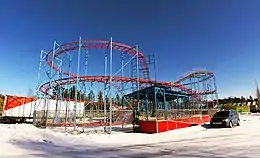
Roller coasters are divided into two main categories: steel roller coasters and wooden roller coasters. Steel coasters have tubular steel tracks, and compared to wooden coasters, they are typically known for offering a smoother ride and their ability to turn riders upside-down. Wooden coasters have flat steel tracks, and are typically renowned for producing "air time" through the use of negative G-forces when reaching the crest of some hill elements. Newer types of track, such as I-Box and Topper introduced by Rocky Mountain Construction (RMC), improve the ride experience on wooden coasters, lower maintenance costs, and add the ability to invert riders.
A third classification type is often referred to as a hybrid roller coaster, which utilize a mixture of wood and steel elements for the track and structure. Many, for example, have a track made out of steel and a support structure made from wood.[24][25][26] RMC has notably redesigned wood coasters that have either deteriorated from age or been deemed by parks as too costly to maintain.[26][27] RMC often replaces the wood track with their patented steel I-Box track design, while reusing much of the ride's wooden structure, resulting in a smoother ride with the incorporation of new design elements, such as inversions, sharper turns, and steeper drops.[27][28]
Although the term wasn't widely used or accepted until the 21st century, one of the oldest examples is Cyclone at Luna Park, which opened in 1927.[29] It features a wood track and steel structure.[30] Other older examples include mine train roller coasters, many of which were built by Arrow Dynamics.[31][32] The term hybrid became more prominent after the introduction of New Texas Giant at Six Flags Over Texas opened in 2011.[33] Many in the industry, however, continue to classify coasters strictly by their track type only, labeling them either steel or wood.[24][34]
Modern roller coasters are constantly evolving to provide a variety of different experiences. More focus is being placed on the position of riders in relation to the overall experience. Traditionally, riders sit facing forward, but newer variations such as stand-up and flying models position the rider in different ways to change the experiences. A flying model, for example, is a suspended roller coaster where the riders lie facing forward and down with their chests and feet strapped in. Other ways of enhancing the experience involve removing the floor beneath passengers riding above the track, as featured in floorless roller coasters. Also new track elements – usually types of inversions – are often introduced to provide entirely new experiences.
By train type
|
By track layout
By mechanics
|
By height
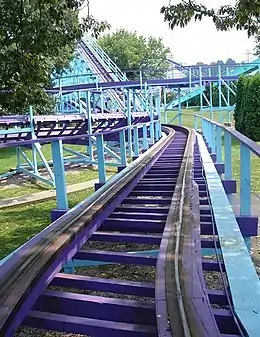
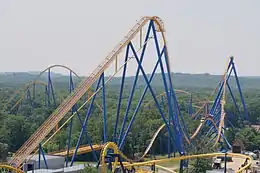
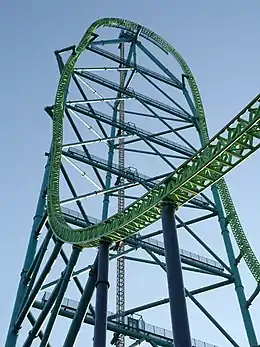
Several height classifications have been used by parks and manufacturers in marketing their roller coasters, as well as enthusiasts within the industry. One classification, the kiddie coaster, is a roller coaster specifically designed for younger riders. Following World War II, parks began pushing for more of them to be built in contrast to the height and age restrictions of standard designs at the time. Companies like Philadelphia Toboggan Company (PTC) developed scaled-down versions of their larger models to accommodate the demand. These typically featured lift hills smaller than 25 feet (7.6 m), and still do today. The rise of kiddie coasters soon led to the development of "junior" models that had lift hills up to 45 feet (14 m). A notable example of a junior coaster is the Sea Dragon – the oldest operating roller coaster from PTC's legendary designer John Allen – which opened at Wyandot Lake in 1956 near Powell, Ohio.[12]
Hypercoaster
A hypercoaster, occasionally stylized as hyper coaster, is a type of roller coaster with a height or drop of at least 200 feet (61 m). Moonsault Scramble, which debuted at Fuji-Q Highland in 1984, was the first to break this barrier, though the term hypercoaster was first coined by Cedar Point and Arrow Dynamics with the opening of Magnum XL-200 in 1989.[35][36] Hypercoasters have become one of the most predominant types of roller coasters in the world, now led by manufacturers Bolliger & Mabillard and Intamin.
Giga coaster
A giga coaster is a type of roller coaster with a height or drop of at least 300 feet (91 m).[37] The term was coined during a partnership between Cedar Point and Intamin on the construction of Millennium Force.[38][39] Although Morgan and Bolliger & Mabillard have not used the term giga,[40] both have also produced roller coasters in this class.
| Name | Park | Manufacturer | Status | Opened | Height | Drop |
|---|---|---|---|---|---|---|
| Millennium Force | Intamin | Operating | May 13, 2000[41] | 310 feet (94 m) | 300 feet (91 m) | |
| Steel Dragon 2000 | Morgan | Operating | August 1, 2000[42] | 318.3 feet (97.0 m) | 306.8 feet (93.5 m) | |
| Intimidator 305 | Intamin | Operating | April 2, 2010[43] | 305 feet (93 m) | 300 feet (91 m) | |
| Leviathan | Bolliger & Mabillard | Operating | May 6, 2012[44] | 306 feet (93 m) | 306 feet (93 m) | |
| Fury 325 | Bolliger & Mabillard | Operating | March 25, 2015[45] | 325 feet (99 m) | 320 feet (98 m) | |
| Red Force | Intamin | Operating | April 7, 2017[46] | 367 feet (112 m) | N/A | |
| Orion | Bolliger & Mabillard | Operating | July 2, 2020[47] | 287 feet (87 m) | 300 feet (91 m) |
Strata coaster
A strata coaster is a type of roller coaster with a height or drop of at least 400 feet (120 m).[37] As with the other two height classifications, the term strata was first introduced by Cedar Point with the release of Top Thrill Dragster, a 420-foot-tall (130 m) roller coaster that opened in 2003.[48] Another strata coaster, Kingda Ka, opened at Six Flags Great Adventure in 2005 as the tallest roller coaster in the world featuring a height of 456 feet (139 m). Superman: Escape From Krypton exceeded 400 feet (120 m) back when it opened in 1997, but its shuttle coaster design where the trains don't travel a complete circuit usually prevents the roller coaster from being classified in the same category.[48][49]
| Name | Park | Manufacturer | Status | Opened | Height |
|---|---|---|---|---|---|
| Top Thrill Dragster | Intamin | Closed | May 4, 2003 | 420 feet (130 m) | |
| Kingda Ka | Intamin | Operating | May 21, 2005 | 456 feet (139 m) |
Major roller coaster manufacturers
- Allan Herschell Company (defunct, merged with Chance Rides)
- Arrow Development (acquired by Huss Trading Corporation, formed into Arrow-Huss)
- Arrow Dynamics (defunct, assets bought by S&S Arrow)
- ART Engineering
- Arrow-Huss (defunct, reformed as Arrow Dynamics)
- B.A. Schiff & Associates
- Bolliger & Mabillard
- Bradley and Kaye (defunct)
- Chance Morgan
- Chance Rides
- Custom Coasters International (defunct)
- D. H. Morgan Manufacturing (acquired by Michael Chance, formed into Chance Morgan)
- Dinn Corporation (defunct)
- Dynamic Structures
- E&F Miler Industries
- Fabbri Group
- Gerstlauer
- Giovanola (defunct)
- The Gravity Group
- Great Coasters International
- Hopkins Rides
- Intamin
- Mack Rides
- Maurer AG
- Martin & Vleminckx
- Philadelphia Toboggan Coasters
- Pinfari (defunct)
- Premier Rides
- Preston & Barbieri
- Reverchon Industries (defunct)
- Ride Engineers Switzerland
- Rocky Mountain Construction
- Roller Coaster Corporation of America (defunct)
- Sansei Technologies
- S&S - Sansei Technologies (formerly known as S&S Worldwide)
- SBF Visa Group
- Schwarzkopf (defunct)
- TOGO (defunct)
- Vekoma
- Zamperla
- Zierer
Gallery
- Roller Coasters
 Tornado, located at Särkänniemi in Tampere, Pirkanmaa, Finland
Tornado, located at Särkänniemi in Tampere, Pirkanmaa, Finland Hypersonic XLC, the world's first production Thrust Air 2000 (now defunct)
Hypersonic XLC, the world's first production Thrust Air 2000 (now defunct)_01.jpg.webp) Top Thrill Dragster at Cedar Point was the first strata coaster ever built.
Top Thrill Dragster at Cedar Point was the first strata coaster ever built. Riding Expedition GeForce at Holiday Park, Germany
Riding Expedition GeForce at Holiday Park, Germany Raptor, a steel inverted coaster, is located at Cedar Point in Sandusky, Ohio, United States.
Raptor, a steel inverted coaster, is located at Cedar Point in Sandusky, Ohio, United States.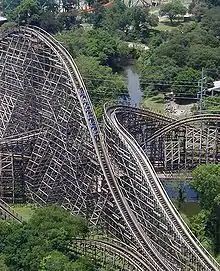 New Texas Giant at Six Flags Over Texas before being refurbished into a hybrid steel-wood coaster.
New Texas Giant at Six Flags Over Texas before being refurbished into a hybrid steel-wood coaster. Lightning Racer at Hersheypark is a racing, dueling roller coaster made by GCI.
Lightning Racer at Hersheypark is a racing, dueling roller coaster made by GCI. This all-wooden roller coaster, built in 1951, dominates the Linnanmäki amusement park in Helsinki, Finland.
This all-wooden roller coaster, built in 1951, dominates the Linnanmäki amusement park in Helsinki, Finland. Coney Island Cyclone in Brooklyn, New York was built in 1927 and refurbished in 1975.
Coney Island Cyclone in Brooklyn, New York was built in 1927 and refurbished in 1975. Son of Beast in Kings Island was the only wooden coaster to have a vertical loop. The loop was removed in 2006, and the ride was closed from 2009 until its demolition in 2012.
Son of Beast in Kings Island was the only wooden coaster to have a vertical loop. The loop was removed in 2006, and the ride was closed from 2009 until its demolition in 2012. Jack Rabbit at Kennywood Park outside of Pittsburgh, Pennsylvania, United States was built in 1920.
Jack Rabbit at Kennywood Park outside of Pittsburgh, Pennsylvania, United States was built in 1920. Phoenix, built in 1947, at Knoebels Amusement Resort in Elysburg, Pennsylvania, United States. It was relocated from San Antonio's Playland Park in 1984.
Phoenix, built in 1947, at Knoebels Amusement Resort in Elysburg, Pennsylvania, United States. It was relocated from San Antonio's Playland Park in 1984. Oblivion at Alton Towers in Staffordshire, England
Oblivion at Alton Towers in Staffordshire, England_02.JPG.webp) Griffon splashing down into a pool at Busch Gardens Williamsburg, US.
Griffon splashing down into a pool at Busch Gardens Williamsburg, US. Great Bear is the first steel inverted coaster in Pennsylvania, located at Hersheypark.
Great Bear is the first steel inverted coaster in Pennsylvania, located at Hersheypark._06.jpg.webp) Behemoth, at Canada's Wonderland, was the highest (70 m or 230 ft) and fastest (124 km/h or 77 mph) coaster in Canada before Leviathan opened.
Behemoth, at Canada's Wonderland, was the highest (70 m or 230 ft) and fastest (124 km/h or 77 mph) coaster in Canada before Leviathan opened. "Montu", a popular inverted roller coaster at Busch Gardens Tampa Bay, US
"Montu", a popular inverted roller coaster at Busch Gardens Tampa Bay, US_06.JPG.webp) Millennium Force
Millennium Force Black Mamba at Phantasialand, Germany
Black Mamba at Phantasialand, Germany Euro-Mir, a spinning roller coaster at Europa-Park in Rust, Germany
Euro-Mir, a spinning roller coaster at Europa-Park in Rust, Germany Dragon Khan at PortAventura Park in Salou (Tarragona), Spain
Dragon Khan at PortAventura Park in Salou (Tarragona), Spain Thunderbolt at Kennywood outside of Pittsburgh, Pennsylvania, US was built in 1968.
Thunderbolt at Kennywood outside of Pittsburgh, Pennsylvania, US was built in 1968. Leviathan, also at Canada's Wonderland, is the current tallest coaster in Canada (93 m or 306 ft, 148 km/h or 92 mph) and is also made by Bolliger & Mabillard. It was the second tallest coaster made by B&M.
Leviathan, also at Canada's Wonderland, is the current tallest coaster in Canada (93 m or 306 ft, 148 km/h or 92 mph) and is also made by Bolliger & Mabillard. It was the second tallest coaster made by B&M. Kingda Ka is the world's tallest roller coaster and is the second strata coaster in the world after Top Thrill Dragster.
Kingda Ka is the world's tallest roller coaster and is the second strata coaster in the world after Top Thrill Dragster. Expedition Everest, a roller coaster at Disney's Animal Kingdom in Walt Disney World
Expedition Everest, a roller coaster at Disney's Animal Kingdom in Walt Disney World A small roller coaster at a local festival in Čakovec, Croatia
A small roller coaster at a local festival in Čakovec, Croatia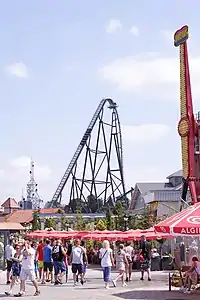 Hyperion at Energylandia in Zator, Lesser Poland Voivodeship, Poland
Hyperion at Energylandia in Zator, Lesser Poland Voivodeship, Poland Fury 325 at Carowinds is the tallest roller coaster ever constructed by B&M and the tallest roller coaster to use a traditional chain lift.
Fury 325 at Carowinds is the tallest roller coaster ever constructed by B&M and the tallest roller coaster to use a traditional chain lift..jpg.webp) Superman The Ride: Welcome to the world of the hypercoaster.
Superman The Ride: Welcome to the world of the hypercoaster. The Cyclone, Revere Beach, Massachusetts, USA
The Cyclone, Revere Beach, Massachusetts, USA
See also
- Amusement park (List of amusement parks)
- RollerCoaster Tycoon
- Thrillville: Off the Rails – video game with roller coaster design simulator
- List of roller coaster rankings
- Train (roller coaster)
References
- "Definition of roller coaster in English". Oxford Living Dictionaries. Archived from the original on October 5, 2017. Retrieved May 28, 2017.
- "Gravity switch-back railway; US patent# 332762". Retrieved May 28, 2017.
- "First roller coaster in America opens - Jun 16, 1884 - HISTORY.com". HISTORY.com. Retrieved 2016-12-30.
- "Roller Coaster Glossary – Roller Coasters". www.ultimaterollercoaster.com.
- Coker, Robert (2002). Roller Coasters: A Thrill Seeker's Guide to the Ultimate Scream Machines. New York: Metrobooks. 14. ISBN 1-58663-172-1.
- <name=Bennett>
- Fierro, Alfred, Histoire et Dictionnaire de Paris p. 613
- Urbanowicz, Steven J. (2002). The Roller Coaster Lover's Companion; Kensington, New YorK: Citadel Press. ISBN 0-8065-2309-3.
- Valérie RANSON-ENGUIALE, " Promenades aériennes ", Histoire par l'image [en ligne], consulté le 26 Mai 2017. URL : http://www.histoire-image.org/etudes/promenades-aeriennes
- "Roller Coaster History: Early Years In America". Retrieved on July 26, 2007.
- Chris Sheedy (2007-01-07). "Icons – In the Beginning... Roller-Coaster". The Sun-Herald Sunday Life (Weekly Supplement). John Fairfax Publications Pty Ltd. p. 10.
- Rutherford, Scott (2004). The American Roller Coaster. MBI. ISBN 0760319294.
- "Patent Images". patimg2.uspto.gov.
- Robb and Elissa Alvey. "Theme Park Review: Japan 2004", themeparkreview.com. Retrieved on March 18, 2008.
- Chris Bergin (November 3, 2006). "NASA will build Rollercoaster for Ares I escape". NASA Spaceflight.com. Archived from the original on 2006-11-15. Retrieved 2007-01-08.
- "Griffin Schobel - Rollercoaster Restraint System (2019)". griffinschobel.com. Retrieved 2022-05-02.
- Hoebiger (2017). Personal restraint hydraulic lock LE. Alabama: Hoebiger.
- Väisänen, Antti (2018). Design of Roller Coasters. Espoo, Finland: Aalto University School of Engineering. p. 11.
- US5715756A, Weigand, Frank K.; Black, Alan & Drobnis, Nick, "Ride attraction anti-roll back system", issued 1998-02-10
- "CoasterForce". CoasterForce. Retrieved 9 May 2022.
- Hunt, Kristen (May 2018). Design Analysis of Roller Coasters. Worcester, MA: Worcester Polytechnic Institute. p. 11.
- National Safety Council (August 2021). "North America Fixed-Site Amusement Ride Injury Survey, 2020 Update". International Association of Amusement Parks and Attractions Orlando, FL. pp. 1–14.
- "Amusement Ride Safety | IAAPA". www.iaapa.org. Retrieved 2022-05-02.
- Weisenberger, Nick (2012). Coasters 101: An Engineer's Guide to Roller Coaster Design (Paperback) (1st ed.). United States: Createspace Independent Publishing. p. 18. ISBN 9781468013559.
- Throgmorton, Todd H.; Throgmorton, Samantha K. (April 30, 2016). Coasters: United States and Canada (E-book) (4th ed.). McFarland, Incorporated, Publishers. pp. 21, 49, 116, 223, 231. ISBN 978-1476622118.
- "What Is a Hybrid Wooden and Steel Roller Coaster?". TripSavvy. Retrieved 2021-04-26.
- "What Is A Hybrid Roller Coaster?". coastercritic.com. Retrieved 2021-04-26.
- "State of the Arts: A New Kind of Wooden Coaster Twists and Turns at Cedar Point". WKSU. 2018-05-04. Retrieved 2021-04-26.
- "Cyclone - Luna Park (Brooklyn, New York, United States)". rcdb.com. Retrieved 2021-04-26.
- "The Cyclone" (PDF). nyc.gov.
- "Arrow Dynamics - Coasterforce". Coasterforce.
- "Roller Coaster Search Results". rcdb.com. Retrieved 2021-04-27.
- "Roller Coaster Search Results". rcdb.com. Retrieved 2021-04-28.
- "New Texas Giant Roller Coaster". Guide to Six Flags over Texas. Retrieved 2021-04-28.
- Meskil, Paul (August 6, 1989). "A Rolling Revival". New York Daily News. Retrieved August 16, 2017.
- "Coaster Landmark Award: Magnum XL-200". American Coaster Enthusiasts. Retrieved August 16, 2017.
- Murphy, Mekado (August 17, 2015). "Just How Tall Can Roller Coasters Get?". The New York Times. Retrieved May 3, 2018.
- "310-Foot-Tall "Giga-Coaster" Nears End of Construction". UltimateRollercoaster.com. March 9, 2000. Retrieved May 3, 2018.
- "Millennium Force". Cedar Point. Retrieved May 3, 2018.
- "Bolliger & Mabillard – Products". Retrieved 13 February 2012.
- "Millennium Force-Cedar Point". rcdb.com.
- "Steel Dragon 2000-Nagashima Spa Land". rcdb.com.
- "Intimidator 305-Kings Dominion". rcdb.com.
- "Leviathan-Canada's Wonderland". rcdb.com.
- "Fury325-Carowinds". rcdb.com.
- "Red Force – Ferrari Land (Salou, Tarragona, Spain)". rcdb.com.
- "Orion – Kings Island (Mason, Ohio)". rcdb.com.
- "National Roller Coaster Day: Ten incredible records for every thrill seeker". guinnessworldrecords.com. August 16, 2016. Retrieved May 3, 2018.
- "Watch the plunge from this new 325-foot roller coaster". USA Today. March 6, 2015. Retrieved May 3, 2018.
Further reading
- Bennett, David (1998). Roller Coaster: Wooden and Steel Coasters, Twisters and Corkscrews. Edison, New Jersey: Chartwell Books. 9. ISBN 0-7865-0885-X.
- Brady, Matthew K.; Knight, David Alan (2001). Rollercoaster Tycoon (Paperback). Prima Games. p. 40. ISBN 9780761537656.
- Cartmell, Robert (1987). The Incredible Scream Machine: A History of the Roller Coaster (Paperback). Amusement Park Books. ISBN 9780879723422.
- Coker, Robert (2002). Roller Coasters: A Thrill Seeker's Guide to the Ultimate Scream Machines. New York: Metrobooks. 14. ISBN 1-58663-172-1.
- Francis, David W.; Francis, Diane DeMali (2002). Ohio's Amusement Parks in Vintage Postcards (Paperback). Arcadia Publishing. ISBN 9780738519975.
- Rutherford, Scott (2004). The American Roller Coaster (Paperback). Motorbooks International. ISBN 9780760319291.
- Urbanowicz, Steven J. (2002). The Roller Coaster Lover's Companion: A Thrill Seeker's Guide to the World's Best Coasters (Paperback). Kensington Publishing Corporation, Citadel Press. ISBN 9780806523095. ISBN 0-8065-2309-3
- Weisenberger, Nick (September 2, 2014). The 50 Most Terrifying Roller Coasters Ever Built (Paperback). Createspace Independent Publishing. ISBN 9781500699963.
External links
- Roller Coaster Glossary
- Roller Coaster History – History of the roller coaster
- Roller Coaster Database – Information, statistics and photos for over 3700 roller coasters throughout the world
- Roller Coaster Patents – With links to the U.S. Patent office
- Roller Coaster Physics – Classic physics explained in terms of roller coasters
- How Roller Coasters Work
- 3D Animated Roller Coaster in MS Excel
- Magic Mountain Announces ‘Twisted’ Plans for Iconic Colossus Roller Coaster